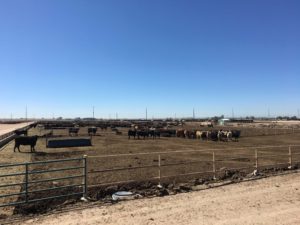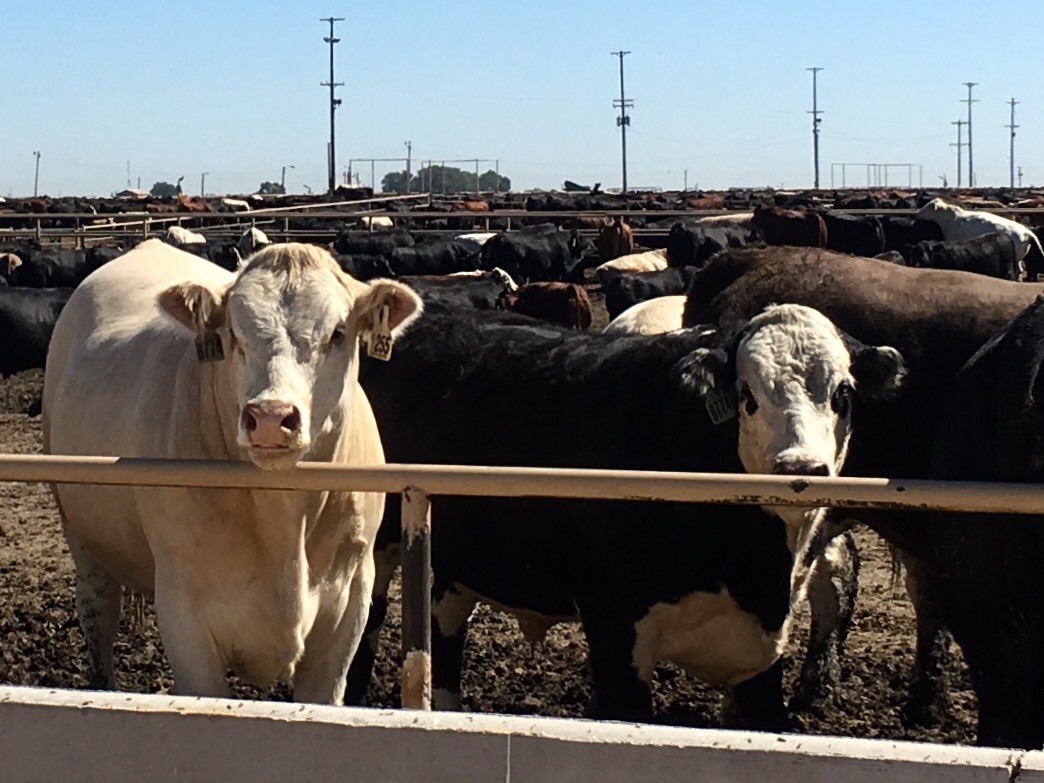By Amy Myrdal Miller, MS, RDN, FAND | Founder & President of Farmer’s Daughter Consulting, Inc.
Disclaimer: I am a member of the Beef Checkoff Beef Expert Bureau for which I receive an annual honorarium. The views expressed in this article are my own.
When a colleague told me she’d gotten a new job, having left a global berry producer to join the sales team for a global beef producer, I was happy for her. When she asked me if I’d like to join her for a tour of their processing plant and feedlot in Colorado, I was happy for me.
I know and appreciate the power of experiential learning. Reading about how cattle are raised, fed, slaughtered, and processed to produce high quality beef for foodservice and retail doesn’t compare to touring the facilities with experts with whom you can ask questions and explore issues most important to you.
My tour started on the fabrication side of the JBS Beef Plant in Greeley, Colorado. I submitted my driver license to security, was greeted by a young gentleman with an undergraduate and master’s degree in meat science, signed paperwork, put on protective gear—including rubber boots, plastic pants guards, a long lab coat, ear protection, a hard hat, and warm gloves—and started the tour.
Our first stop was the locker where sides of beef were hanging, waiting for fabrication. Each half carcass had a tag, indicating weight and other specifications. I was amazed at the consistency in weight with carcasses weighing between 885 to 950 pounds. I watched company and USDA grading inspectors grade beef with remarkable speed. Visuals aids for marbling and size of the ribeye aid their work. Inspectors change shifts every 30-minutes to ensure eye fatigue doesn’t affect their performance.
We then moved on to the fabrication floor where highly skilled employees break down the beef into specific cuts with respect and ease. Their knife skills were impressive and their smiles warm and welcoming. Supervisors’ watchful eyes helped newer employees perfect their cuts to reduce waste. Sustainability and efficiency in beef production includes thoughtful utilization of every ounce of beef.
I gingerly moved throughout the fabrication floor with my guide as carcasses moved along their conveyor system, trying not to get hit. With this I was successful. But I did manage to get blood on my boots and pant covers. I was now realizing why all this gear was necessary.
It was now time to leave the fabrication side, the “cool side” and move to the “hot side” of the facility. I had toured a similar operation in California three years earlier, so I was somewhat prepared for what was to come. But like most humans, I have a good ability to block out unpleasant memories.
First, I noticed the temperature difference as my glasses fogged up. Our guide stopped for three or so minutes so my glasses and I could adjust. We moved forward to watch employees packing internal organs into boxes. From there we moved to the slaughter line, watching as cattle just killed hung from their hind quarters on chains, gently swaying, bleeding out from the chest, and moving along a conveyor system.
This was not pleasant. I watched as a worker with a metal face mask for protection and a full rubber body suit swept coagulating blood into a floor drain. I thought to myself, “Of all the jobs here, that is the one I least want.” But I was also really thankful there are people willing to do this work. So much work in our food systems goes unnoticed, unappreciated. Getting food from the farm to our homes is difficult. We’re blessed to live in a country where access to affordable, safe, high quality food is so easy for so many.
From there we watched as employees trimmed hooves, removed heads, and started to strip the hides off the carcasses. I watched with fascination rather than horror. I was so impressed by the respect and reverence of the employees.
I opted to not see everything, including the evisceration of internal organs. But I did want to see the electrical stimulation system, developed by Texas A&M, designed to quickly reduce meat Ph in the carcass, thereby improving meat quality, flavor, and tenderness.
As we left the “hot side” to go back into the administration wing to remove protective gear, my tour guide asked if I had any questions. I wanted to confirm the name of the best knife I’d seen, a round one used to quickly shave external fat on certain larger cuts of beef from 1-inch to 1/4-inch. “Was it a whisker trimmer?” I asked. He laughed and said, “It’s a whisper knife.” The ear protection meant some facts were lost in translation.
It was now time to head out to the feedlot, located about 40-minutes from the harvest and processing plant. I was excited but also filled with dread. I have a keen sense of smell.
When you grow up on a farm with a large cow-calf operation, you know all too well the off-putting aromas of manure. A south wind in early spring was awful when I was a child. It meant the thawing manure in the winter feedlot would release odors that would bring tears to your eyes as your left the farmhouse for the yard.
We parked in front of the office and stepped out of my colleague’s rental car. I was ready for the worst. But all I could smell was silage, or fermented, chopped corn stalks and cobs. The wind must be blowing in the wrong direction, I thought.
Our guide for the feedlot tour was a 40-year veteran employee, the assistant general manager. We started in the employee lunch room before hopping in his Ford King Cab truck. He gave me an overview of the feedlot operation that, per its CAFO permit, can feed up to 100,000 cattle at one time. “Right now, we only have 88,000 cattle across our 550 acres of feedlots.” I braced myself for the odor. “We are surrounded by 450 acres of land on which we produce some of the feed for the cattle, including hay and corn.”
They also have a feed processing plant on-site. Some of the corn is turned into silage, but most of it is turned into steam corn flakes. “The steaming process converts the starch in the field corn into a more valuable form of feed. The cattle can get about 15% more energy from the processed corn, which makes our feed more efficient at getting the cattle to market weight,” explained our guide. This is yet another example of innovation in the cattle industry that improves sustainability.
“Each cow has  about 160 square feet of space, which is similar to what college students living in dorms today have,” he commented. I smiled, knowing cattle are herd animals. Even with that much space for each animal, cows like being with their friends and will huddle together in one corner of a feedlot versus spreading out (as seen in this photo).
about 160 square feet of space, which is similar to what college students living in dorms today have,” he commented. I smiled, knowing cattle are herd animals. Even with that much space for each animal, cows like being with their friends and will huddle together in one corner of a feedlot versus spreading out (as seen in this photo).
We first drove by the haylage and silage piles as we headed out to drive through the feedlots. I bravely rolled down my window to take some photos. “Why doesn’t it smell worse?” I asked. Our guide smiled. “That’s because of our neighbor, the genius behind the compost operation that flanks the east and west sides of our feedlots. He collects beneficial bacteria from all over the world to help break down manure from our facility into valuable compost. A few years ago, he offered me a few five-gallon buckets of compost to inoculate our waste pond. It worked so well in reducing odor that we then started spraying the feedlots to reduce dust with that water. We now have an amazingly fresh smelling feedlot, thanks to the bacteria whisperer.” How incredible! Good bacteria do wonders in our guts, in our soil, and in our feedlots!
“Do others use this same system for controlling odor?” I inquired. “People are starting to tour our facility to learn more about this,” he replied.
The final stop on the feedlot tour included a visit to one of four water filtration units. Water for the cattle is continuously filtered through sand and UV light to that water can be conserved. “Water is a limited resource here in the high plains. Our filtration system allows us to use water very judiciously. Our cattle always have fresh water due to this system I designed,” he said proudly.
I owe great thanks to my colleague for providing this incredible opportunity. I learned so much on my tour of the beef plant and feedlot. I have much greater appreciation for the researchers and professionals who are continually striving to improve the sustainability of beef production in the U.S.

